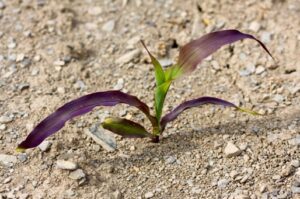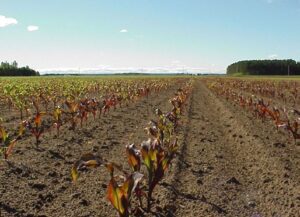Purple Corn Genetics

Some genetics are more prone to development of purple color under cool spring conditions. Plants outgrow genetic purpling with no adverse effect on yield.
- Purple corn syndrome commonly shows up in corn fields every year, typically following periods of low temperatures.
- Purple seedling color results from the expression of anthocyanin pigment formation.
- Most corn hybrids contain five of the eight genes required to produce the purple color.
- The other three genes are only present in certain hybrids, and some of these genes are cold sensitive.
Impact on Crop

This cross section of corn leaf tissue illustrates the accumulation of anthocyanin pigments. Notice the purple pigmentation is produced in the top layer of cells and does not affect the chlorophyll content in the plant.
- Testing of corn plants that exhibit genetic purpling at the seedling stage has shown no evidence of adverse effects on metabolism, growth, or yield.
- Hybrids that develop the purple pigment when exposed to cold temperatures have been found to contain as much chlorophyll (the green pigment) as hybrids that remain green when grown under the same cool conditions.
Cold Conditions Trigger Purple Corn

Purple corn as a result of a genetic tendency for this trait. The hybrid on the left out-yielded the hybrid on the right by 8 bu/acre.
- Nighttime air temperatures below 50ºF (10 ºC) when day temperatures are above 60ºF (15º C) are often adequate to trigger purpling.
- These temperature sensitive genes are only expressed in the seedlings prior to the 6-leaf stage of growth, which coincides with the period most likely to have low temperatures.
- Corn normally outgrows the purpling condition by the time it is 12 inches (30 cm) tall. This can occur quickly if the weather warms up and corn grows rapidly, or it can be slow if the weather remains cool, retarding both root and shoot growth in the seedling.
- Slower growth is caused by the cool temperatures, not the purple pigment.
Phosphorus Deficiencies

Corn seedling showing purple color due to phosphorus deficiency. This can be a result of phosphorus tie-up in high pH soil as well as sugar beets or canola as the previous crop.
- Phosphorus deficiency symptoms can be manifested as an accumulation of purple pigments in leaves.
- Phosphorus level, as determined by soil tests and an examination of the fertility programs used, may determine whether phosphorus is likely deficient.
- If sufficient levels of phosphorus are already present, adding extra phosphorus will not turn purple seedlings green.
Genetic Purpling vs Phosphorus Deficiency
How can growers tell the difference between genetic purpling and symptoms of phosphorus deficiency?
- First, examine the color of plants over the entire field. If the purple color is uniform through the field, the cause is probably genetic.
- If purpling is quite erratic, this may indicate that phosphorus is limiting to plants in those areas.
- If plants are beyond the seedling stage (more than six to eight leaves) and purpling is observed, then phosphorus deficiency is likely.
Uneven Purpling

Purple corn due to environmental conditions. Cold weather causes the accumulation of anthocyanin pigment leading to purple color.
- If purpling is not uniform it may indicate soil fertility problems or inhibited root development.
- Since the inhibited root system may not take up enough phosphorus for normal growth, plant sugars accumulate in the plant and it “shows” the purple color.
- If plants are beyond the seedling stage (more than 6 to 8 leaves) and purpling is observed, then phosphorous deficiency is likely.
- Phosphorus level, as determined by soil tests and an examination of the fertility programs used, may determine whether phosphorus is likely deficient.
- If sufficient levels of phosphorus are already present, adding extra phosphorus will not turn purple seedlings green.
Root Development Inhibition Causes
- Cool soil and night temperatures
- Soil conditions, either dry cool soils or wet poorly drained soils
- Shallow planting
- Soil compaction
- Seed slot compaction or ‘smearing’
- Low phosphorus availability (especially on low or high pH soils)
- Insect or nematode damage
- Seedling diseases
- Herbicide overlaps or over-applications
- Fertilizer injury
